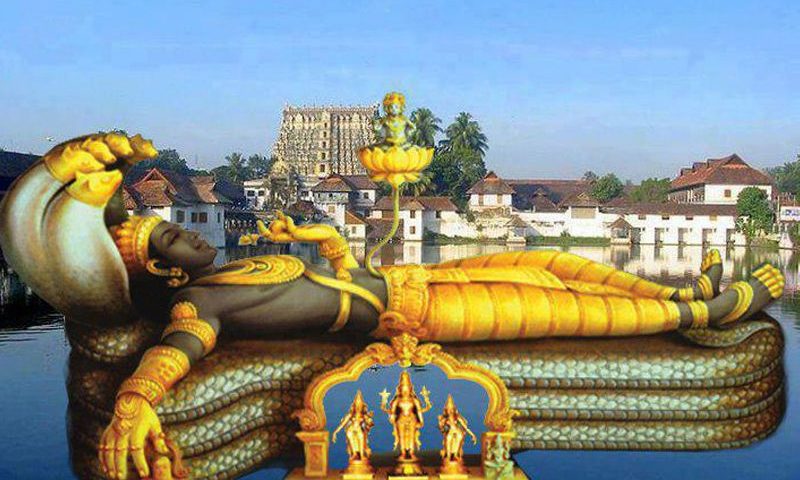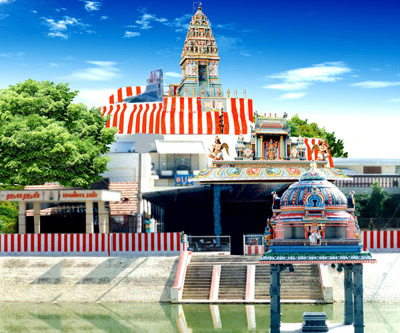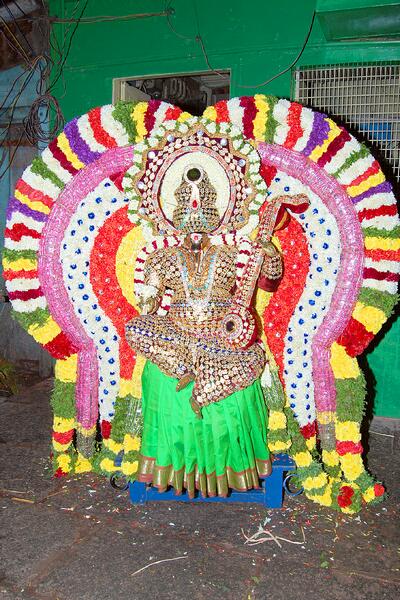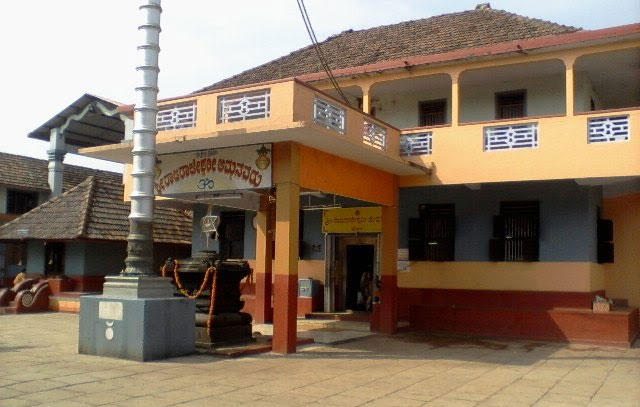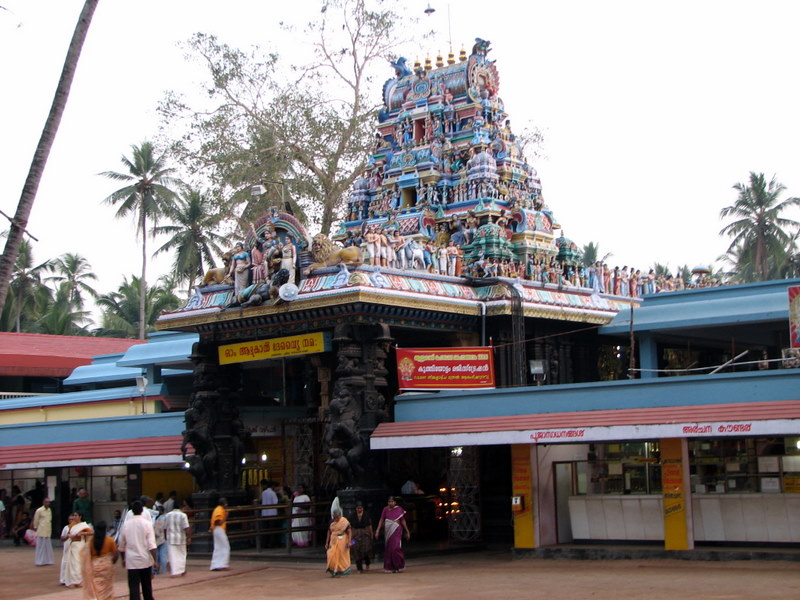Main God:
Sree Padmanabha Swamy

Location:
Mathilakom Office, West Nada
Sree Padmanabha Swamy Temple
Fort, Thiruvananthapuram – 695023.
Festival:
Vinayaka Chathurthi :
This event comes on the Chathurthi tithi on Karuthapaksham(New Moon) of Chingam. Special offerings and deeparadhana are conducted for the Ganesh idol in the Sree Rama Shrine. ‘Chirappu’ is observed for the Agrashala Ganapathi. The Valiya Thampuran (eldest male member of the royal family) worships here only on this day and witnesses the deeparadhana.
Thiruvonam:
This is one among the most major celebrations of this Temple by virtue of the fact that it is the Thirunal (Birthday) of Sree Padmanabhaswamy. The Temple celebrates this day in the manner laid down long ago. Of special note is the submission of the Onavillu to the Deities. It has a tradition of centuries behind it.
Ashtami Rohini:
Sree Krishnaswamy’s birth day is celebrated all over India in the month of Chingam when the asterism Rohini and the thithi Ashtami coincide. In this Temple special decorations and offerings mark this day. The Temple opens early in the noon by 2 pm. At 2.30pm abhishekam of milk is performed to Sree Krishna. On this day an exquisitely decorated ivory cradle is placed on the Abhisravana Mandapam and number of images of Lord Krishna are kept inside for the devotees to view. It is believed that if prayer is offered to them by childless couples, they will be blessed with infants.
Navarathri Pooja:
In connection with the Navarathri festival Sree Saraswathi Amman is brought from Padmanabhapuram Palace in Kanyakumari District and worshipped traditionally in the Navarathri Mandapam at the Valiya Kottaram complex. Huge crowds throng for darshan. Sree Kumaraswamy from Kumarakovil and Sree Muthuttee Nanga from Suchindram also accompany Her in grand procession.
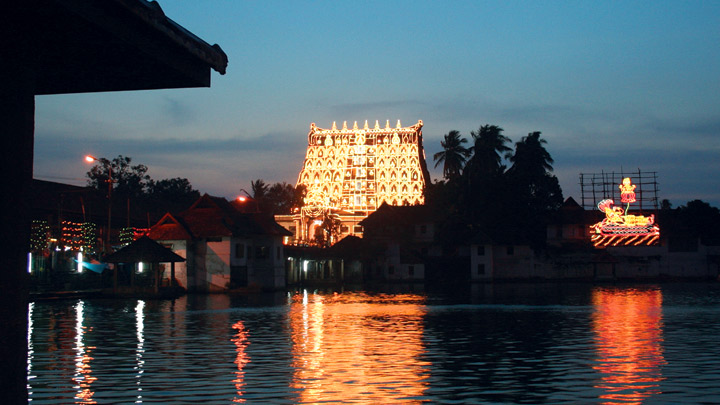
Valiya Ganapathi Homam:
This is carried out for twelve days starting two days before the commencement of the Navarathri Festival, by the Tharananalloor Namboodiripads who are Tantries of the Temple.
Alpasi Ulsavam:
Sree Padmanabhaswamy Temple celebrates bi-annual festivals in the months of Thulam (Alppasi) and Meenam(Painkuni). A function is conducted for according formal sanction to conduct the Ulsavam(festival). This is known as Anujna. Other functions include Mannuneeru Koral, Mula Pooja, Kalasam, etc. The festival starts with Kodiyettu(flag hoisting) at Sree Padmanabhaswamy’s gold and Sree Krishnaswamy’s silver flag poles. The festival is of ten days duration culminating in the spectacular Palliveta and Arat processions on the 9th and 10th days respectively. Kalasams also known as Ulsava Kalasams take place in addition to the routine rituals. Special Sreebalies (Processions) are conducted twice a day, in the evening 4.30 pm and at night 8.30pm.Exception is there on the first day when there is only night Sreebali.
Once during the reign of Sree Anizhom Thirunal Marthanda Varma, an elephant ran amock. Since then, the practice of using elephants to carry the idols in the procession was given up and Vahanas (vehicles) carried on the shoulder by a number of priests came into vogue. Six different kinds of beautiful conveyances are used for these processions. They are the Simhasana Vahanam(Throne), Anantha Vahanam(Serpant), Kamala Vahanam(Lotus), Pallakku Vahanam(Palanquin), Garuda Vahanam(Garuda) and Indra Vahanam(Gopuram). Of these the Pallakku and Garuda Vahanas are repeated twice and four times respectively. The Garuda Vahanam is considered as the favorite conveyance of the Lord. The different days on which the various Vahanams are taken out for the procession are as follows.
1st day of Utsavam Simhasana Vahanam
2nd day of Utsavam Anantha Vahanam
3rd day of Utsavam Kamala Vahanam
4th day of Utsavam Pallakku Vahanam
5th day of Utsavam Garuda Vahanam
6th day of Utsavam Indra Vahanam
7th day of Utsavam Pallakku Vahanam
8th day of Utsavam Garuda Vahanam
9th day of Utsavam Garuda Vahanam
10th day of Utsavam Garuda Vahanam
Sree Padmanabhaswamy’s Vahanam is in gold while those of Narasimha Swamy and Krishna Swamy are in silver. The Vahanams are richly decorated with colourful flowers.
The eighth Utsavam has significance in the sense that ‘Valiya Kanikka’ is offered. During the night Sreebali the Swamiyar offers the first Kanikka followed by the Valia Thampuran(the eldest male member of the Royal Family).
The ninth day festival is called Pallivetta. Pallivetta signifies a royal hunt. As the Ruler of the land, the Swamy ventures to hunt down and annihilate all the ills. In a temporarily erected grove, the Maharaja as the representative of the Lord, aims an arrow on a tender coconut which symbolizes evil. The Valiya Thampuran and other male members of the Royal Family array outside with swords and shields, and accompany the procession.
The difference in the Garuda Vahanam used for the Pallivetta and Aarat is that the Anki (outer covering) of the image of Lord Padmanabhaswamy holds a bow and an arrow in the hands.
On the tenth day is the Aarat. After two circumambulations, all the Vahanams are taken out through the Western entrance. The Valiya Thampuran and other male members of the Royal Family escort the Deities with drawn swords and shields.
The Aarat procession slowly proceeds with pomp and pageantry, colour and music, men carrying divine emblems and insignias of royalty. History and heritage are re-lived. The procession reaches the Sanghumugham beach and the Vahanams are positioned in the Aarat Mandapam. Poojas are performed to the idols by the Tantri (Tantri is of the Tharanalloor Illam. This Illam has held the position of Tantri for centuries) and the holy immersion in the sea takes place. After this, the procession returns to the Temple.
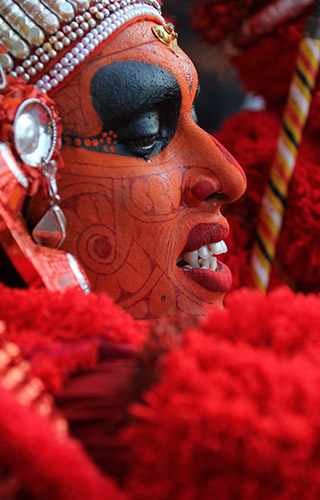
Mandala Chirappu:
The celebration for the Sastha begins on the first of Vrischikam. Mandalachirappu falls on the 41st day.
Swargavathil Ekadasi:
This is an auspicious day for the devotees of Maha Vishnu. On this day people throng the Temple. Special poojas, offerings and night Siveli take place. The Temple remains open for longer duration.
Bhadradeepam
Bhadradeepam is observed on the summer and winter solstices. On these day Bhadradeepappura is opened and special poojas are made.
Kalabham:
This is conducted for seven days commencing from the last six days of Dhanu and Midhunam. The ablution with sandal paste on the idols is the highlight of the function.
Makara Sreebali:
A night Sreebali observed on winter solstice (Utharayanam).
Sivarathri:
This is a day celebrated all over India as important for Sree Parameswara. On this day special Abhishekam is done to the Shiva residing in the Sanctum.
Painkuni Utsavam:
All the rituals and functions which take place for this Utsavam are same as for Alpasi Festival, the difference being the asterism. While prominence is given to the star Thiruvonam under which alone the Arat takes place for Alpasi, for Painkuni the emphasis is on the day of Kodiyettu (flag hoisting) on which the asterism is Rohini. In connection with this festival the massive figures of Pandavas are erected at the Eastern entrance of the Temple.
Sree Rama Navami:
Special poojas are performed on this day for Sree Rama.
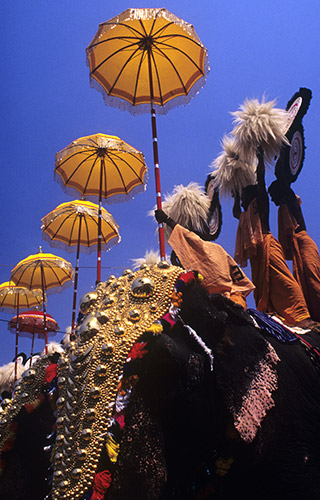
Vishu:
Vishu is an extremely auspicious day for Malayalees. Vishukani is arranged inside the sanctum of all shrines in this Temple complex. The Temple opens an hour earlier for Vishukkani Darshanam.
Karkataka Sreebali:
On the first day of the Malayalam month Karkkitakam solstice (Dakshinayanam) the Karkkitaka Sreebali takes place. Its procedure is same as the Makara Sreebali.
Sree Veda Vyasa Jayanthi:
Sree VedaVyasa Jayanthi is celebrated on the full moon day of Karkkitakam in honour of the great sage Vyasa who resides in his separate shrine. Sree Veda Vyasa consecrations are rare.

Niraputhari:
On the day of Niraputhari sheaves of grain are ceremoniously brought to the Temple. The chief priest removes some sheaves from the bundle after performing pooja to the same and takes them inside the sanctum of Sree Padmanabha Swamy and submits them. Some sheaves are spread out on the Ottakkal Mandapam. This procedure takes place in all the other shrines of this Temple complex.
Murajapam:
The very term reveals its meaning. ‘Mura’ means turn and ‘Japam’ means chanting. This prayer lays tremendous stress on the chanting of Vedas and the Vishnu Sahasranamam( thousand names of Maha Vishnu). It is celebrated once in six years. It comprises 56 days of Veda chanting, Sahasranama Japam and rituals.
Lakshadeepam:
Lakshadeepam literally translates as one lakh lamps. The entire Temple is adorned with lamps. The Sreebali (Procession) conducted with illumination on the concluding day of Murajapam is known as Lakshadeepam. The maiden Lakshadeepam was celebrated on the 1st of Makaram 925 ME / 14th or 15th of January 1750 AD. The festival was conducted with much pomp and fanfare, in the grandest manner possible by King Marthanda Varma. The latest Lakshadeepam was celebrated in 2008. The next one is due in 2014. It still continues as an immensely grand festival and visual magnitude attracting staggering numbers to the doors of this great Temple.
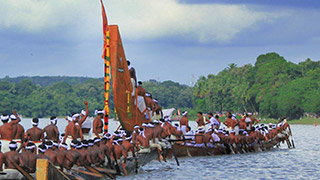
Worship Timing:
Morning:
03.30 am to 04.45 am (Nirmalya Darshanam)
06.30 am to 07.00 am
08.30 am to 10.00 am
10.30 am to 11.10 am
11.45 am to 12.00 Noon
Evening:
05.00 pm to 06.15 pm
06.45 pm to 07.20 pm
History:
Several extant Hindu Texts like the Brahma Purana,Matsya Purana, Varaha Purana, Skanda,Padma Purana,Vaya Purana,Bhagavatha Purana, and theMahabaratha amention this shrine. According to the Bhagavata Lord Balarama visited Phalgunam (more commonly known as Thiruvananthapuram), took bath in Panchapsaras (Padmateertham) and made a gift of ten thousand cows to holy men Though the sannidhyam of Lord Padmanabha has always been present in the holy land of Thiruvananthapuram making it a pilgrim spot even during the time of Balarama, the Temple for the Lord came up much later. The Temple has been referred to in the (only recorded)Sangam Period ofLiterature between 500 B.C and 300 A.D several times. Many conventional historians and scholars are of the opinion that one of the names that the Temple had – “The Golden Temple” – literally was in cognizance of the fact that the Temple was already unimaginably wealthy by that point. Many extant pieces of Sangam Tamil literature and poetry, and even the later works of Ninth Century poet-saints like Nammalwar, refer to the Temple and even the city as having walls of pure gold.At some places, both the Temple and the entire city are often eulogized even as being made of gold, and the Temple as Heaven.
The temple is one of the 108 principal Divya Desams in Vaishnavisamand is glorified in the Divya prabandha The Divya prabandha glorifies this shrine as being among the 13 Divya Desam in Malai Nadu (corresponding to present-day Kerala and some adjoining areas).The 8th century Alvar Nammalvarsang the glories of Padmanabha.The Anantha puram in Kasargod is believed to be the ‘Moolasthanam’ of the Temple.
The sage Vilvamangalathu Swamiyar, who resided near in Anantha puram Kasargod District, prayed to Lord Vishnu for his darshan “auspicious sight”. The Lord is believed to have come in the guise of a little boy who was mischievous. The boy defiled the Idol which was kept for Puja. The sage became enraged at this and chased away the boy, who disappeared. After a long search, when he was walking on the banks of Arabian Sea, he heard a pulaya lady threatening her child that she would throw him in Ananthankadu. The moment the Swami heard the word Ananthankadu he was delighted. He proceeded to Ananthankadu based on the directions of the lady of whom he enquired.

The Sage reached Ananthankadu searching for the boy. There he saw the boy merging into an Iluppa tree (Indian Butter Tree). The tree fell down and became Anantha Sayana Moorti (Vishnu reclining on the celestial snake Anantha). But the edifice that the Lord assumed was of an extraordinarily large size, with His head at Thiruvallom, navel at Thiruvananthapuram, and lotus-feet at Thrippadapuram (Thrippappur), making him some eight miles in length. The Sage requested the Lord to shrink to a smaller proportion that would be thrice the length of his staff. Immediately the Lord shrank to the form of the Idol that is seen at present in the Temple. But even then many Iluppa trees obstructed a complete vision of the Lord. The Sage saw the Lord in three parts – thirumukham, thiruvudal and thrippadam. Swami prayed to Padmanabha to be forgiven. The Swami offered Rice Kanji and Uppumanga (salted mango pieces) in a coconut shell to the Perumal which he obtained from the pulaya woman. The spot where the Sage had darsan of the Lord belonged to Koopakkara Potti and Karuva Potti. With the assistance of the reigning King and some Brahmin households a Temple was constructed. Koopakkara Potti was made the Tantri of the Temple.The Ananthankadu Nagaraja Temple still exists to the north west of the Padmanabhaswamy Temple. The Samadhi (final resting place) of the Swamiyar exists to the west of the Padmanabha Temple. A Krishna Temple was built over the Samadhi. This Temple, known as Vilvamangalam Sri Krishna Swami Temple, belongs to Thrissur Naduvill Madhom


